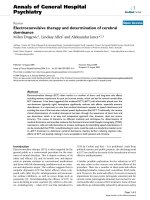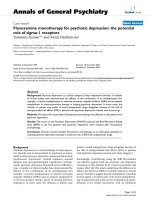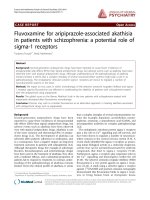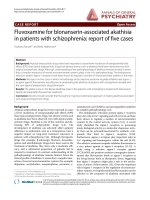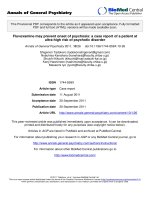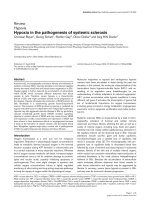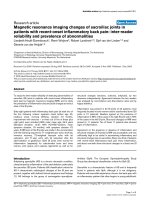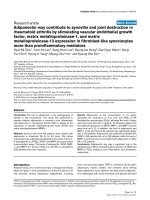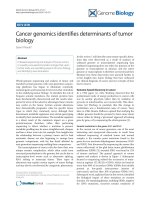Báo cáo y học: "Fluvoxamine may prevent onset of psychosis: a case report of a patient at ultra-high risk of psychotic disorde" ppt
Bạn đang xem bản rút gọn của tài liệu. Xem và tải ngay bản đầy đủ của tài liệu tại đây (126.56 KB, 8 trang )
This Provisional PDF corresponds to the article as it appeared upon acceptance. Fully formatted
PDF and full text (HTML) versions will be made available soon.
Fluvoxamine may prevent onset of psychosis: a case report of a patient at
ultra-high risk of psychotic disorder
Annals of General Psychiatry 2011, 10:26 doi:10.1186/1744-859X-10-26
Shigenori Tadokoro ()
Nobuhisa Kanahara ()
Shuichi Kikuchi ()
Kenji Hashimoto ()
Masaomi Iyo ()
ISSN 1744-859X
Article type Case report
Submission date 11 August 2011
Acceptance date 30 September 2011
Publication date 30 September 2011
Article URL />This peer-reviewed article was published immediately upon acceptance. It can be downloaded,
printed and distributed freely for any purposes (see copyright notice below).
Articles in AGP are listed in PubMed and archived at PubMed Central.
For information about publishing your research in AGP or any BioMed Central journal, go to
/>For information about other BioMed Central publications go to
/>Annals of General Psychiatry
© 2011 Tadokoro et al. ; licensee BioMed Central Ltd.
This is an open access article distributed under the terms of the Creative Commons Attribution License ( />which permits unrestricted use, distribution, and reproduction in any medium, provided the original work is properly cited.
Fluvoxamine may prevent onset of psychosis: a case report of a patient at
ultra-high risk of psychotic disorder
Shigenori Tadokoro
1,2,
*, Nobuhisa Kanahara
1
, Shuichi Kikuchi
2
, Kenji Hashimoto
3
and Masaomi Iyo
1,3
1
Department of Psychiatry, Chiba University Graduate School of Medicine, Chiba,
Japan
2
Department of Psychiatry, Sodegaura Satsukidai Hospital, Chiba, Japan
3
Division of Clinical Neuroscience, Chiba University Center for Forensic Mental
Health, Chiba, Japan
*
Corresponding author
Email addresses:
ST:
NK:
SK:
KH:
MI:
Abstract
Background: There is emerging evidence that antidepressants may be effective in
preventing patients with non-specific and psychotic-like prodromal symptoms,
defined as patients at ultra-high risk (UHR) of psychotic disorder, from transitioning to
psychosis. However, the mechanism of such an effect is still unknown.
Methods: We report the case of a 19-year-old Japanese man determined to be at
UHR of psychotic disorder in whom fluvoxamine (one of the antidepressants with
sigma-1 receptor agonism) showed preventive effects on psychotic-like prodromal
symptoms.
Results: Our patient’s depressive symptoms were reduced and maintained below
remission as a result of treatment with 100 mg/day of fluvoxamine. In addition, it is
likely that an additional dose of fluvoxamine (50 mg/day) improved his psychotic-like
prodromal symptoms directly, independent of its antidepressive effects.
Conclusion: Fluvoxamine, a sigma-1 receptor agonist, may be effective in
preventing patients at UHR of psychotic disorder from onset of psychosis via its
neuroprotective/neurotropic actions, independent of its antidepressive effects.
Background
In the past decade there has been increasing interest in the potential benefit of early
pharmacological intervention in psychotic disorders. Patients with psychotic
disorders show non-specific and psychotic-like prodromal symptoms preceding the
onset of frank psychosis. Interestingly, there is emerging evidence that
antidepressants may be effective in preventing patients who are at ultra-high risk
(UHR) of psychotic disorder from transitioning to psychosis [1]. However, it is still
unknown whether such prevention of psychosis onset by antidepressants is due to
their antidepressive effects, such as mood improvement, or other pharmacological
effects, such as neuroprotection. We present the case of a patient at UHR of
psychotic disorder in which fluvoxamine, a selective serotonin reuptake inhibitor
(SSRI) administered alone, prevented the onset of psychosis, independent of its
antidepressive effects.
Case presentation
The patient was a 19-year-old Japanese unmarried office worker with no personal or
familial history of psychiatric problems. On presentation he complained of
deterioration of his work performance. He had suffered from anhedonia, insomnia,
loss of appetite, concentration deficit, and a sense of guilt for over 1 month, and was
diagnosed with major depressive disorder according to Diagnostic and Statistical
Manual of Mental Disorders, 4th Edition, Text Revision (DSM-IV-TR) criteria. His
baseline score on the 17-item Hamilton Depression Rating Scale (HAM-D) was 23
points [2], and his Global Assessment of Functioning (GAF) score was 55 points [3].
Treatment with 50 mg/day of fluvoxamine was started. Then, 3 weeks later, his
depressive symptoms improved and his fluvoxamine dose was increased to 100
mg/day. At 7 months after the start of treatment, his depressive symptoms
disappeared (HAM-D score: 6). During the next 5 months, his quality of life (QoL)
remained stable with satisfactory performance in his work (GAF score: 80).
About 1 year after the start of treatment, the patient’s work performance deteriorated
suddenly (GAF: 65) despite continuous treatment with 100 mg/day of fluvoxamine,
without any concurrent symptoms of depression such as depressive mood or
anhedonia. Then, 2 months later, he reported having a peculiar, highly confusing
sensation that two work colleagues who were living in the same dormitory had
spoken ill of him, unfairly accusing him of wearing unwashed clothes, among other
things. In response, he had begun to delay his meal and bath times in order to shun
contact with them, and to do his laundry several times a day. His QoL was highly
disturbed and his work performance had worsened accordingly (GAF: 50). His
disordered thoughts of persecution persisted for several months, and he was
therefore diagnosed with UHR (attenuated psychosis group) under the criteria of the
Comprehensive Assessment of At-Risk Mental States [4]. His fluvoxamine dose was
increased to 125 mg/day. Then, 1 month later, he began to relax his efforts to avoid
his colleagues and his QoL improved (GAF: 65). His fluvoxamine dose was further
increased to 150 mg/day. At 1 month after that, he said brightly ‘I don’t care about
them so much’, and his QoL improved still further (GAF: 80). Treatment with 150
mg/day of fluvoxamine was maintained, and his QoL remained stable with
satisfactory performance in his work, which lasted for more than 2 years of follow-up.
Ethical approval
The treatment of the reported case was made according to standard clinical practice,
and ethical approval was obtained from the Ethics Committee of Sodegaura
Satsukidai Hospital, Japan.
Discussion
To the best of our knowledge, this is the first report showing that fluvoxamine alone
prevented a UHR patient from onset of psychosis. In this case, the patient’s
depressive symptoms were reduced and maintained below remission as a result of
treatment with 100 mg/day of fluvoxamine. Therefore, it is estimated that the
additional dose of fluvoxamine (50 mg/day) improved his psychotic-like prodromal
symptoms directly, independent of its antidepressive effects.
Although the treatment with fluvoxamine modified the natural course of the case,
psychotic-like symptoms never appeared during the major depressive episode.
Furthermore, the patient’s idea of persecution by his colleagues was odd and
incongruent with his mood. Therefore, we estimated that both his psychotic-like
symptoms and depressive symptoms were the prodromal symptoms of a UHR
patient, rather than symptoms of psychotic major depression. Previously, Häfner et al.
studied untreated psychotic and depressive symptoms retrospectively from onset
until first admission, and demonstrated that delusional misinterpretations or
delusional references were highly specific to schizophrenia (80.3% schizophrenia vs
6.2% unipolar depression), although the frequency of depressive symptoms showed
surprising similarities between the two studied groups [5].
Although most antidepressants share blockade of serotonin transporters as a core
mechanism, we reported that some antidepressants possess high to moderate
affinity for the endoplasmic reticulum protein sigma-1 receptors [6], which are
implicated in neuroprotection and neuronal plasticity [7-10]. Among all
antidepressants, including SSRIs and typical tricyclic antidepressants, fluvoxamine
has shown the most potent action at sigma-1 receptors, suggesting that sigma-1
receptors might be involved in fluvoxamine’s mechanisms of action [6]. In cell culture
systems, fluvoxamine, but not sertraline or paroxetine, stimulated nerve growth
factor-induced neurite outgrowth in PC12 cells, and the effect of fluvoxamine was
antagonized by treatment with the selective sigma-1 receptor antagonist NE-100
[11,12], suggesting that the agonism of fluvoxamine plays a role in neuronal
plasticity.
We have previously hypothesized that the sigma-1 receptor agonist fluvoxamine
might reduce the risk of subsequent transition to psychosis via its
neuroprotective/neurotrophic actions [13]. To the best of our knowledge, this is the
first case report supporting our hypothesis.
Conclusions
This case suggests that fluvoxamine, a sigma-1 receptor agonist, may be effective in
preventing patients at UHR of psychotic disorder from onset of psychosis. More
detailed randomized, double-blind placebo-controlled studies using a large sample
size will be needed to confirm this.
Consent
Written informed consent was obtained from the patient for publication of this case
report. A copy of the written consent is available for review by the Editor-in-Chief of
this journal.
Competing interests
The authors declare that they have no competing interests.
Authors’ contributions
ST, NK, and SK contributed to the clinical and rating evaluations during the follow-up
periods. KH and MI conceived of the study and participated in its execution and
coordination. All authors read and approved the final manuscript.
References
1. Fusar-Poli P, Valmaggia L, McGuire P: Can antidepressants prevent
psychosis? Lancet 2007, 370:1746-1748.
2. Hamilton M: A rating scale for depression. J Neurol Neurosurg Psychiatry 1960,
23:56-62.
3. Endicott J, Spitzer RL, Fleiss JL, Cohen J: The global assessment scale. A
procedure for measuring overall severity of psychiatric disturbance. Arch
Gen Psychiatry 1976, 33:766-771.
4. Yung AR, Yuen HP, McGorry PD, Phillips LJ, Kelly D, Dell'Olio M, Francey SM,
Cosgrave EM, Killackey E, Stanford C, Godfrey K, Buckby J: Mapping the onset
of psychosis: the Comprehensive Assessment of At-Risk Mental States.
Aust N Z J Psychiatry 2005, 39:964-971.
5. Hafner H, Maurer K, Trendler G, an der Heiden W, Schmidt M, Konnecke R:
Schizophrenia and depression: challenging the paradigm of two separate
diseases a controlled study of schizophrenia, depression and healthy
controls. Schizophr Res 2005, 77:11-24.
6. Narita N, Hashimoto K, Tomitaka S, Minabe Y: Interactions of selective
serotonin reuptake inhibitors with subtypes of sigma receptors in rat brain.
Eur J Pharmacol 1996, 307:117-119.
7. Hashimoto K, Ishiwata K: Sigma receptor ligands: possible application as
therapeutic drugs and as radiopharmaceuticals. Curr Pharm Des 2006,
12:3857-3876.
8. Hayashi T, Su TP: Sigma-1 receptor chaperones at the ER-mitochondrion
interface regulate Ca(2+) signaling and cell survival. Cell 2007, 131:596-610.
9. Hayashi T, Su TP: An update on the development of drugs for
neuropsychiatric disorders: focusing on the sigma 1 receptor ligand. Expert
Opin Ther Targets 2008, 12:45-58.
10. Hashimoto K: Sigma-1 receptors and selective serotonin reuptake inhibitors:
clinical implications of their relationship. Cent Nerv Syst Agents Med Chem
2009, 9:197-204.
11. Takebayashi M, Hayashi T, Su TP: Nerve growth factor-induced neurite
sprouting in PC12 cells involves sigma-1 receptors: implications for
antidepressants. J Pharmacol Exp Ther 2002, 303:1227-1237.
12. Nishimura T, Ishima T, Iyo M, Hashimoto K: Potentiation of nerve growth
factor-induced neurite outgrowth by fluvoxamine: role of sigma-1 receptors,
IP3 receptors and cellular signaling pathways. PLoS One 2008, 3:e2558.
13. Hashimoto K: Can the sigma-1 receptor agonist fluvoxamine prevent
schizophrenia? CNS Neurol Disord Drug Targets 2009, 8:470-474.
